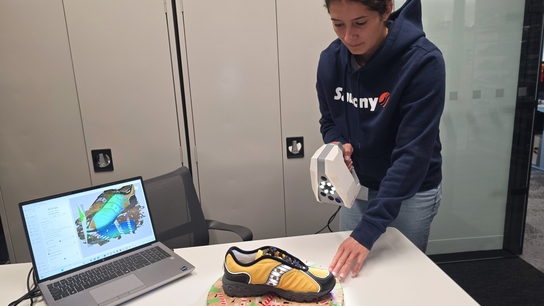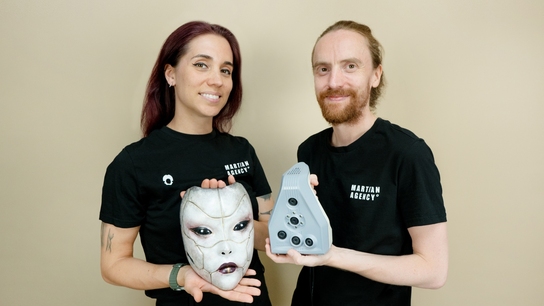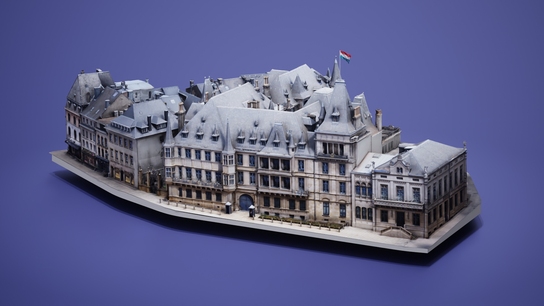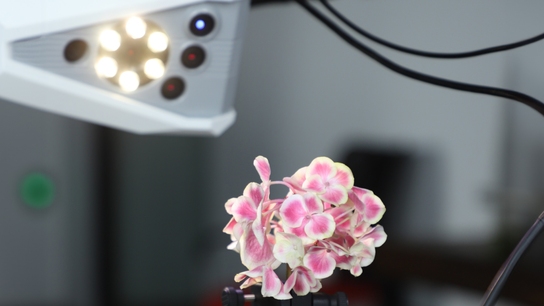Pioneering research clears the name of forensic bitemark analysis with Artec 3D scanning
Challenge: Identifying a more accurate and reliable means of measuring human bite marks so they can be used as forensic evidence in sexual assault trials.
Solution: Artec Space Spider, Artec Studio, Autodesk 3ds Max
Result: A revamped process, in which Artec’s blue light-powered Space Spider digitizes bite marks with such pace and precision that resulting data can be used to sift through suspects.
Why Artec 3D?: Already utilized in forensics, Artec Space Spider and software Artec Studio allow bite marks to be turned into one-to-one models for tooth cast comparison with unmatched precision and repeatability, making them the obvious tools for the job.

Researcher Erika Franze digitizing a dental casting with Artec Space Spider. Image courtesy of Erika Franze
It’s not a pleasant subject, but bite marks are often at the heart of sexual assault cases, as they tend to be found on the breasts, legs, and genitalia of victims, as well as on attackers.
However, bitemark analysis itself remains a controversial topic. From the sheer variability and complexity of human dentition, to distortions caused by skin elasticity, pressure, and changes post-mortem, the waters around the subject are murky at best.
Another issue that further complicates things is the absence of a standardized method for bitemark documentation. This lack of consistency opens the door to subjectivity and bias in interpreting bite marks and casts shadows over the validity of research results.
Over the years, bitemark analysis has even been implicated in several instances of wrongful convictions, where findings were later overturned by DNA evidence. Such are the ethical and legal implications of mismatching bite marks, it’s now widely accepted that dental evidence needs to be corroborated to ensure its legal credibility.
What is bitemark analysis?
Traditionally, bite marks are documented via a series of photographs. Once these have been taken, the area is swabbed for any DNA left behind by the perpetrator. Suspects then have impressions taken of their teeth as a further test to see if there’s a match.

Bite marks being 3D scanned with Space Spider before being compared to photographs. Image courtesy of Erika Franze
But bitemark bruising changes depending on a victim’s condition. In some cases, this means forensic dentists have to wait until the lividity stage – the discoloration of skin after death when details become more visible – before they take pictures, delaying their investigation.
Then there’s preservation. With deceased victims, silicone casts can be made of bite marks, and stored in disinfectant to prevent degradation. Survivors may also have evidence of bites ‘traced’ onto acetate sheets, but both processes are hugely time-consuming.
Amid these drawbacks and doubts, it could be said that forensics grad student Erika Franze’s research has introduced a ray of hope into the field.
Harnessing the power of handheld submillimeter 3D scanning, Franze has developed a way of precisely capturing the angle of every tooth involved in the making of a mark. This not only allows depth, shape, and size to be measured accurately but yields data that can be turned into 3D models for comparison with suspects’ dental casts.

A traditional 3D dental cast. Image courtesy of Eugene Liscio
“Brilliant” scans in seconds
Developed alongside professor and renowned forensic scientist Carol Ritter, Franze’s revised process largely revolves around 3D scanning. However, not all scanners are created equally. Some struggle to capture faint, distorted, or contaminated bite marks in a way that could see errors or artifacts creep in due to resolution, calibration, or alignment issues.
Fortunately, Franze was introduced to the Artec Space Spider early in her research by Eugene Liscio, a 3D Forensic Analyst with extensive experience of using 3D technologies in forensic documentation applications.
“I really like how it doesn’t keep me in one spot,” explained Franze. “It’s mobile enough to bring with me to meet sampling volunteers whenever they are. It’s also just really fun to use.”
Space Spider’s high resolution and ease of use made it the perfect tool for helping a complete scanning newcomer capture the often-overlooked details key to forensic outcomes.
“Every image captured looks brilliant,” she added. “To me, the scans look like dentition casts. There are no major flaws, blurring, noise, or landmarks. Space Spider really gets everything I’m looking for, right down to the smaller points of the teeth.”
“I was new, so 3D scanning took a bit of learning from me, but now the scanning part takes less than a minute – fully rotating the teeth and everything.”
Reimagining forensic dentistry
In Franze’s contact-free preservation workflow, 3D models of marks can be shared seamlessly with investigation partners without risk of infection or cross-contamination. This allows bitemark depth to be visualized more effectively for shape, size, and dental cast comparison, or even the simulation of different biting scenarios.
Unlike regular casts, which require physical storage, making them prone to cracking and damage during handling, digital models don’t have this issue either.
When it comes to capture, Artec Studio is also key to the seconds-long scanning process. Franze has found the software’s Autopilot mode a particularly useful way of streamlining the alignment of scans and ensuring that they match a bite mark’s true size and orientation.
“Artec Studio’s automated mode was so nice and easy to use and super-fast,” said Franze. “I did also learn the manual model editing steps, just for comparison, but there wasn’t a huge difference between them – which was impressive!”

A screenshot of Artec Studio taken midway through the 3D scanning process. Image courtesy of Erika Franze
Once tidied up, scans are exported to modeling, rendering, and animation platform Autodesk 3ds Max, where if needed, they can be used alongside 2D images to create a ‘virtual bite outline.’ The resulting model is so accurate, it can be utilized to compare differences in texture and angle between teeth, and ultimately rule people in or out as suspects.
Forensic 3D scanning: the future?
Already tested on 15 volunteers, in trials that have yielded accurate dental casts and imprints, Franze’s approach is well on its way to becoming a game-changer for forensic dentistry.
“Two things can look the same and be very different. To make my research as objective as possible, I’m using statistics to back my analysis up,” concluded Franze. “Space Spider has been a huge help with that – its scans are like looking at something with your own eyes.”

An edited dental 3D model. Image courtesy of Erika Franze
While her research remains focused on comparing dentition casts to photos, adopting Space Spider has opened the door to exciting approaches to bitemark modeling. In fact, she now aims to develop a way of drawing conclusions using only the high-resolution data from bite impression scans, which could bring precision and credibility to a controversial field.
“If there is a pathway to bitemark analysis being more generally accepted, it will very likely include some form of 3D documentation and geometric analysis,” added Liscio. “3D scanning can be a gateway to greater objectivity. A lot of these methods and standards have not yet been established. But this is definitely the starting point and how we get there.”
Scanners behind the story
Try out the world's leading handheld 3D scanners.





